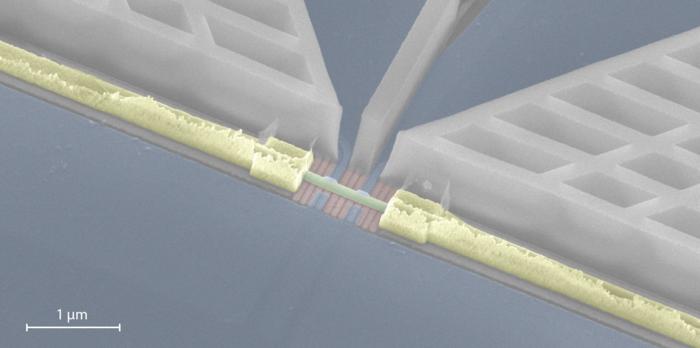An international research team led by QuTech has made significant strides in the field of quantum computing by successfully realizing a three-site Kitaev chain using semiconducting quantum dots. This innovative device utilizes a hybrid InSb/Al nanowire and integrates superconducting segments, which enhances the stability of Majorana zero modes (MZMs). This breakthrough comes after the researchers compared two-site and three-site chains within the same device, leading to the conclusion that the extension of Kitaev chains to three sites significantly increases the stability of these zero-energy modes that are critical for future quantum technologies.
Majorana zero modes are theoretical quasiparticles predicted to emerge at the edges of topological superconductors. They are particularly noteworthy because of their anticipated non-Abelian exchange statistics, which are a cornerstone for the realization of topological quantum computation. This makes topological superconductors a compelling candidate in the quest for decoherence-free quantum computing, which aims to facilitate stable and high-fidelity quantum gates essential for future quantum computers.
The Kitaev model plays a pivotal role in the understanding of one-dimensional topological superconductors. It introduces a chain of spinless fermions that are coupled through p-wave superconductivity and electron hopping. The transition to a topological state becomes possible with the presence of longer chains. Researchers focused on enhancing the scope of their work by realizing a three-site Kitaev chain that not only supports MZMs but also demonstrates increased stability compared to previous two-site configurations.
The construction of this three-site Kitaev chain is part of a broader effort to explore the applications of topological superconductivity. Over the past decade, multiple experimental platforms have emerged as possible candidates for this field. A minimal Kitaev chain, which was previously established by QuTech, consisted of two quantum dots linked through superconducting pairing. Although this two-site chain did support MZMs, their low stability became a point of concern, leading researchers to refer to them as “poor man’s MZMs.” The transition to three sites aims to mitigate the impact of local noise and chemical potential variations that have plagued earlier models.
Notable contributions to this research initiative came from various experts within QuTech, including Leo Kouwenhoven and Grzegorz Mazur, as well as first authors Alberto Bordin and Chun-Xiao Liu. They collaborated closely with Erik Bakkers’ team at the Technical University of Eindhoven to develop the three-site Kitaev chain, which consists of three semiconducting quantum dots connected by superconducting segments. The team’s efforts were focused on enhancing the stability of Majorana zero modes by optimizing the configuration of the quantum dots and superconducting materials.
The findings indicate that as the Kitaev chain lengthens from two to three sites, MZMs show increased stability in the new configuration. This observation provides a hopeful outlook for scaling the device further, allowing for the potential creation of longer chains that maintain robustness against perturbations. The researchers are optimistic about the implications of their findings regarding the scalability of Kitaev chains, which could significantly enhance the prospects for stable Majorana zero modes in quantum computing applications.
Mazur expressed the excitement of the team regarding their findings, noting the clear advancement from two-site to three-site chains. The improved stability of Majorana zero modes in these extended configurations not only opens doors for theoretical applications but also holds promise for technological advancements in quantum computing. Moving forward, the research team aims to expand the Kitaev chains even further, potentially incorporating five or six sites, and explore their implications for next-generation quantum technologies.
As part of an ongoing research endeavor at QuTech, the goal encompasses not just the creation of functional devices but also understanding and demonstrating how these Kitaev chains can serve as qubit candidates in quantum information experiments. The researchers are particularly keen to study how the lengths of the Kitaev chains influence qubit lifetimes. Responses to electrical noise are foundational in this discussion since two-site chains have displayed concerning levels of instability, while the stabilized three-site chains seem to pave the way for more reliable quantum operations.
Lengthening the Kitaev chain configuration presents unique research opportunities, especially as the quest for topological protection unfolds. Bordin mentioned the potential use of machine learning techniques to assist in fine-tuning these chains towards achieving topological protection. The research team is strategically laying the groundwork that could lead to the first practical quantum computing techniques, illustrating the slow yet steady progress toward more advanced quantum architectures.
In addition to understanding the electrical characteristics and behavior of these new chains, the QuTech researchers are planning to conduct quantum information experiments to explore the performance of these Kitaev chains under various scenarios. The team is eager to gain insights into how factors such as noise and operational conditions might impact qubit performance and to ascertain whether these chains can be reliably utilized as qubits in complex quantum systems.
As they continue their progress, Kouwenhoven and his colleagues have plans to investigate additional configurations, potentially coupling the three-site Kitaev chains with further quantum dots to elevate their functional capabilities. Their ongoing research reflects a robust commitment to advancing the understanding of topological superconductors and their real-world applications in quantum technology.
Through these explorations, the research team envisions a future where scalable topological qubits could revolutionize quantum computing methodologies, achieving the long-desired goal of fault-tolerant quantum computation. Their work thus represents a critical step forward in harnessing the power of quantum mechanics to potentially transform how computations are carried out on a fundamental level.
Coupling these findings with upcoming research could inspire novel experimental designs, ultimately propelling the field of quantum computing into new realms of stability and scalability. As the scientific community closely watches these developments, the implications of such breakthroughs may redefine the landscape of quantum technologies in the years to come.
Subject of Research: Three-site Kitaev chain using semiconducting quantum dots and superconducting segments.
Article Title: Enhancing Majorana stability with a three-site Kitaev chain
News Publication Date: 31-Mar-2025
Web References: Nature Nanotechnology
References: DOI: 10.1038/s41565-025-01894-4
Image Credits: QuTech
Keywords: Quantum computing, Kitaev chain, Majorana zero modes, Topological superconductors, Quantum dots.




